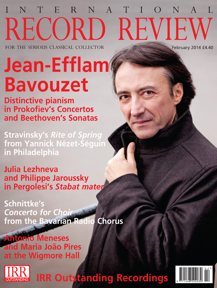Texte paru dans: / Appeared in:
*

International Record Review - (02//2014)
Pour
s'abonner / Subscription information
Aparté
AP070

3149028041224 (ID358)
Of all the claims made for the ‘48 ‘ one of the most surprising to me is that it presents a ‘musical self-portrait’ of Bach, who apparently views himself with ‘serenity and nostalgia on the one hand, and courage, even revolt, on the other’ . But such is Gilles Cantagrel’s belief as laid out in his essay with this recording of the second book of Das wohltemperierte Clavier. I do not initially recognize anything in Christophe Rousset’s interpretations which might support that view, but then hearing these Preludes and Fugues recorded at, such close proximity on the harpsichord places them under a very direct aural spotlight which shows up the technical and structural detail at the expense of anything more obviously esoteric. (Against so many recent recordings which have put this repertory firmly in the piano’s considerably more affectionate clutches, this harpsichord seems positively aggressive with its purposefully plucked notes and very physical release at the end of each piece.) On the other hand Rousset frequently refers in his own booklet note to the music’s physicality, likening the performing of the second book to ‘attempting Everest’, and sprinkling his essay with phrases such as ‘obstacle course’ and ‘athletic exercise’. It is certainly this element in the music which seems the most obvious at first hearing this new recording.
Rousset is unquestionably a player of impeccable and immaculate technical command, fluent and precise in touch, compelling in his choice of tempos and authoritative in his grasp of structure. These are performances largely devoid of nuance or interpretative weightiness, and while there is something rather mechanical about the driving momentum of this playing in the opening C major Prelude (Rousset twice uses the word ‘continuum’ in his brief analysis of the piece), there is none of the breathless relentlessness of so many earlier harpsichord recordings of Bach. Rarely does Rousset admit any elasticity in the pulse, just occasionally pulling it out to emphasize a point or, as in the C sharp minor Prelude, to bring out the music’s more reflective character, but it breathes easily, moments of rest and repose brought about by a widely varied range of articulation.
Rousset also writes of his desire to ‘humanise’ the music. Never one to dwell on finer points of detail at the expense of a purposeful forward momentum (something highlighted by his obsession with clipping the final cadences of each very short indeed), Rousset’s crisp and businesslike playing does nevertheless have a sense of humanity in its occasional touches of exuberance (there is a gloriously festive account of the D major Prelude), moments of gentle happiness (the F sharp major Prelude skips like a new-born lamb) as well as unaffected sorrow (F sharp minor), his poised lyricism (E flat major Prelude) and subtle glimpses of humour (there is a richly jaunty account of the B major Prelude as well as a wonderfully bouncy C sharp major Fugue) . But these purposeful and precise performances which give the music clearly and directly, untroubled by the kind of intense psychological introspection the booklet essays might seem to suggest.
Lavishly illustrated with details from the richly
decorated harpsichord case as well as stunning photographs of the interior
and exterior of the château at Versailles (where the harpsichord currently
resides and where the recording was made), the booklet is in itself a fine
work of art, and beyond the two detailed background essays includes
Rousset’s piece-by-piece analysis of all 24 Preludes and Fugues as well as
an extensive description of the instrument written by the harpsichord maker
Alain Anselm. It is a two-manual harpsichord made in Antwerp in 1628 by
Joannes Ruckert and once in the possession the painter Boissard, where it
appears to have figured at the notorious hashish parties held at his home on
the Quai d’Anjou in Paris, famously depicted in Gautier’s painting Le
Club. Anselm suggests that the instrument itself featured in a lost
1850s painting (Un concert) in which ‘splendid young women are seen
seated at a harpsichord happily playing from scores and singing’. It has
spent virtually its entire life in Paris (arriving at Versailles in 1946)
and was modified to suit French tastes in the early eighteenth century by
Nicolas Blanchet. During the twentieth century it was also subjected to some
highly unsympathetic alterations, which, in 2009, Anselm removed in his bid
to restore it as close as possible to its Blanchet manifestation.
Fermer la fenêtre/Close window
Cliquez l'un ou l'autre
bouton pour découvrir bien d'autres critiques de CD
Click either button for many other reviews


